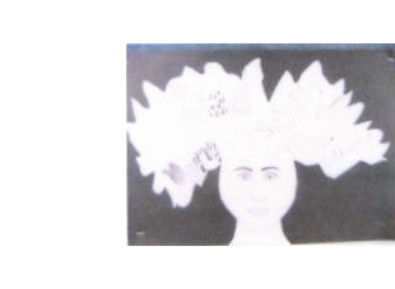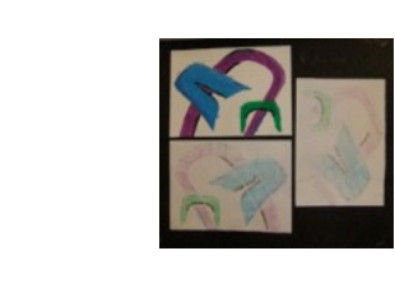Fifth/Sixth Grade Art Kits - Descriptions & Links to Lesson Plans
4 months ago
American Portraits
American Portraits
Students learn about portraits and draw an interesting American. They use a grid and their math skills to help them see and draw the portrait, one square at a time. Photos are provided of many interesting Americans—students may find and substitute a different photo. Grid drawing is a technique that can be applied to helping a student draw many things.

Andy Goldsworthy; Art from the Earth
Andy Goldsworthy; Art from the Earth
Students study Andy Goldsworthy, a British artist who transforms nature into art, photographs it, and lets it return to nature. They then go outside to create art from only nature -- no tools allowed! When done, they photograph their work and write about the art they made and the process they used.

Cooperative Paper Sculptures: Creating Spaces
Cooperative Paper Sculptures: Creating Spaces
Students work cooperatively with a partner to make a standing sculpture with paper and tape, exploring the idea of creating spaces in art, or "negative space." The process of working together gives structure for taking turns and responding to each other, almost like an art "conversation."
-kl0aru.jpg)
Crazy Hair Day
Crazy Hair Day
Students learn the proportions of a human face and practice these and other tips for drawing faces in a self-portrait. Students add “crazy hair” to this portrait, and write the names of people who have taught them something into the hair. Texture and value are added to the hair with cross-hatching and patterns.

Deep Space
Deep Space
Students learn how to use a light source to create a sphere from a circle. Students create planets using oil pastels and learn a blending technique to give the impression of form. By arranging the planets and accenting the composition with stars and shooting stars, the finished product creates the illusion of Deep Space.

Diatoms: Microscopic Jewels
Diatoms: Microscopic Jewels
Students are introduced to the 17th-century Dutch scientist Antonie van Leeuwenhoek, the microscope he developed, his discoveries and his methods of recording those discoveries. They create a colorful microscopic view of diatoms using watercolors and black crayon 'resist.'

Drawing from Observation: Egg Shadows
Drawing from Observation: Egg Shadows
Students use a flashlight and an egg to investigate how light source direction changes shadows. Students learn to show shading on the round form of the egg and record through their drawings, a highlight, form shadow and cast shadow. Class set of flashlights and eggs are provided in the kit.
-dmqm7n.jpg)
Formline and Beyond with Jim Schoppert
Formline and Beyond with Jim Schoppert
Students learn about the non-traditional work of Jim Schoppert, Tlingit artist. They create a cut-paper printing plate of a non-traditional design using traditional Northwest Coast formline shapes. They make prints from this plate using a method of oil pastels and heat caused by friction. Students mount and name their abstract art.

Georgia O'Keeffe Meets Mark Kelley
Georgia O'Keeffe Meets Mark Kelley
Students study American artist, Georgia O’Keeffe, and local photographer, Mark Kelley. With deer bones as models, students draw from observation, then place their bone in a southeast Alaska landscape provided by Mark Kelley calendar pages. Students enjoy finding just the right “focal point” for their picture, using the hole in the bone as a view finder.

Inside and Outside of Me
Inside and Outside of Me
Students consider prejudice and tolerance by exploring ways in which we are all alike. They then learn about four “artist heroes” who drew their creative strength from accepting and nurturing their personal differences. Students investigate the concept of tolerance by creating an “inside and outside of me self-portrait” using words, color, and pattern.

Graphic Design: Fontsense!
Graphic Design: Fontsense!
In this digital lesson, students learn what fonts are, how they communicate, and how fonts are organized into font families. They make informed designed choices and use a Chromebook to create a business card for their dream job.

Graphic Design: Walking with Words (Tlingit Language Posters)
Graphic Design: Walking with Words (Tlingit Language Posters)
In this digital art lesson, students watch a short video of a local Tlingit elder sharing the meaning of several Tlingit phrases and the importance of words. Students are guided through using graphic design decisions with Google slides to create posters that express the meaning of these words.

Moon Moods
Moon Moods
Students create a Tlingit style cut out paper moon to use in making rubbings with crayons. In their rubbings students depict the moon in different phases to show different emotions that they may be feeling or have felt.

Monochromatic Mystery
Monochromatic Mystery

Northwest Coast Formline Design
Northwest Coast Formline Design
An art kit created by Sealaska Heritage Institute and provided with their permission to the Juneau School District Teachers: "In this project we give your students an introduction to formline design shapes and definitions, the importance of balance in the design form and to ways an experienced Native artist would compose a formline design. We then provide them with tools to create their own formline design."

Papel Picado
Papel Picado
Students learn about the Mexican tradition of making Papel Picado, cut paper banners. They learn three different folds for making these beautiful strings of banners created for the Day of the Dead and other celebrations in Mexico and other Latin American countries.

Paper Marbling
Paper Marbling
A partner STEAM lesson to Concentrations and Solubility Science kit. Choosing a complementary or analagous color scheme, students use paint sprinkled and "designed" on the surface of a solution to create a marbled effect, then print this on papers. Resulting papers can be made into notecards or collages.
-96ebgj.jpg)
Paper Quilts
Paper Quilts
Students work in small cooperative groups to agree on a set of artistic “rules” regarding a species of butterfly. Each child then makes a cut paper collage that follows those rules, and the group displays their unique, but similar artworks in a group “paper quilt.” It is recommended that students get the opportunity to experience this lessonn both as a fourth grader and as a fifth grader.

Plein Air Postcards
Plein Air Postcards
In this indoor lesson, students mimic the art of painting outdoors, "plein air painting." They learn to show "perspective" in a landscape. Using special paintbrushes which hold water, they make a small watercolor sketch landscape of a region of the U.S. These can be used as postcards. The lesson is a perfect way to prepare students to paint while on a class field trip.
